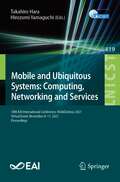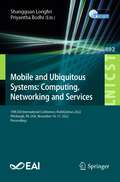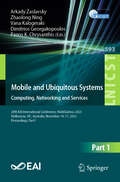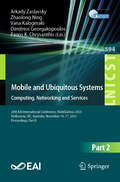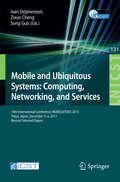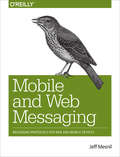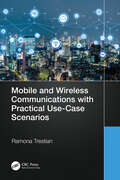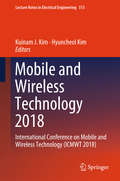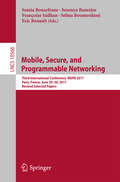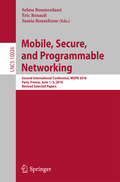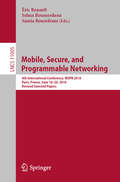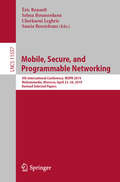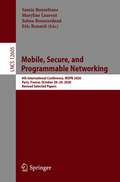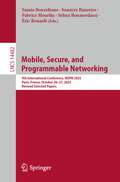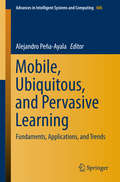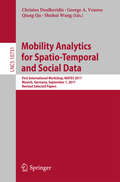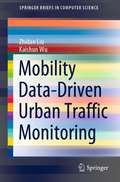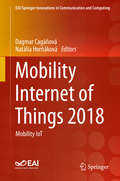- Table View
- List View
Mobile and Ubiquitous Learning
by Mohamed Ally Shengquan Yu Avgoustos TsinakosThis book explores the latest trends and technologies in the field of mobile and ubiquitous learning. It highlights best practices in technology-enhanced learning, and explores how new technologies such as mobile, augmented and wearable technologies are shaping instructional design strategies and the content curriculum development process. The book consists of approximately 20 chapters, written by international experts in the field of mobile and ubiquitous learning. The authors hail from Austria, Brazil, Canada, China, Greece, India, Malaysia, Mauritius, Saudi Arabia, Spain, Sweden, and the United Kingdom. Topics covered include but are not limited to: Use of social media in mobile learning, Contexts of learning and challenges of mobility: Designing for formal, informal, and non-formal learning, Mobile virtual reality: a promising technology to change the way we learn and teach, Mobile applications for encyclopedias, Ethical considerations in the incorporation of mobile and ubiquitous technologies into teaching and learning, Use of augmented reality in mobile learning for students with disabilities, Using wearable technology to support transfer of expertise, and Core technologies in mobile learning. Providing valuable insights on the future of education and the upcoming pedagogies that will be applied in traditional, distance and blended learning, the book offers educators and stakeholders essential guidance in making innovations for the new generations of learners in the 21st century.
Mobile and Ubiquitous Systems: 18th EAI International Conference, MobiQuitous 2021, Virtual Event, November 8-11, 2021, Proceedings (Lecture Notes of the Institute for Computer Sciences, Social Informatics and Telecommunications Engineering #419)
by Takahiro Hara Hirozumi YamaguchiThis book constitutes the refereed post-conference proceedings of the 18th International Conference on Mobile and Ubiquitous Systems: Computing, Networking and Services, MobiQuitous 2021, which was held in November 2021. The conference was held virtually due to the COVID-19 pandemic.The 37 full papers were carefully reviewed and selected from 79 submissions and present discussions, interaction and exchange of experiences that will designate future research efforts and directions. Topics addressed by the conference include systems, applications, social networks, middleware, networking, sensing, data management, data processing and services, all with special focus on mobile and ubiquitous computing.
Mobile and Ubiquitous Systems: 19th EAI International Conference, MobiQuitous 2022, Pittsburgh, PA, USA, November 14-17, 2022, Proceedings (Lecture Notes of the Institute for Computer Sciences, Social Informatics and Telecommunications Engineering #492)
by Shangguan Longfei Priyantha BodhiThis book constitutes the refereed post-conference proceedings of the 19th International Conference on Mobile and Ubiquitous Systems: Computing, Networking and Services, MobiQuitous 2022, which was held in Pittsburgh, November 14-17, 2022. The conference was held virtually due to the COVID-19 pandemic.The 26 full and 2 short papers were carefully reviewed and selected from 95 submissions and present discussions, They were organized in topical sections as follows: Internet of Things (IoT), Security and Privacy, Human-centric sensing, Drone applications and edge computing, Wireless networks, Mobile and human computer interactions, Poster and demo sessions, Technology for health
Mobile and Ubiquitous Systems: 20th EAI International Conference, MobiQuitous 2023, Melbourne, VIC, Australia, November 14–17, 2023, Proceedings, Part I (Lecture Notes of the Institute for Computer Sciences, Social Informatics and Telecommunications Engineering #593)
by Arkady Zaslavsky Dimitrios Georgakopoulos Panos K. Chrysanthis Vana Kalogeraki Zhaolong NingThese two-volume proceedings constitute the refereed post-conference proceedings of the 20th EAI International Conference on Mobile and Ubiquitous Systems: Computing, Networking and Services, MobiQuitous 2023, held in Melbourne, Australia, during November 14-17, 2023. The 65 papers presented in these proceedings were carefully reviewed and selected from 161 submissions. The conference papers are organized in topical sections on: Part I - Tracking and Detection; IoT; Federated learning; Networks; Activity recognition; Security Management; Urban/Mobile Crowdsensing. Part II - Urban/Mobile Crowdsensing; Edge computing; Crowdsourcing, Platforms and localization; Activity recognition and prediction; AI and machine learning; Mobile edge and fog computing; Mobile augmented reality and applications for mobile computing; interaction technologies; AutoQuitous workshop.
Mobile and Ubiquitous Systems: 20th EAI International Conference, MobiQuitous 2023, Melbourne, VIC, Australia, November 14–17, 2023, Proceedings, Part II (Lecture Notes of the Institute for Computer Sciences, Social Informatics and Telecommunications Engineering #594)
by Arkady Zaslavsky Dimitrios Georgakopoulos Panos K. Chrysanthis Vana Kalogeraki Zhaolong NingThese two-volume proceedings constitute the refereed post-conference proceedings of the 20th EAI International Conference on Mobile and Ubiquitous Systems: Computing, Networking and Services, MobiQuitous 2023, held in Melbourne, Australia, during November 14-17, 2023. The 65 papers presented in these proceedings were carefully reviewed and selected from 161 submissions. The conference papers are organized in topical sections on: Part I - Tracking and Detection; IoT; Federated learning; Networks; Activity recognition; Security Management; Urban/Mobile Crowdsensing. Part II - Urban/Mobile Crowdsensing; Edge computing; Crowdsourcing, Platforms and localization; Activity recognition and prediction; AI and machine learning; Mobile edge and fog computing; Mobile augmented reality and applications for mobile computing; interaction technologies; AutoQuitous workshop.
Mobile and Ubiquitous Systems: Computing, Networking, and Services
by Ivan Stojmenovic Song Guo Zixue ChengThis book constitutes the thoroughly refereed post-conference proceedings of the 10th International ICST Conference on Mobile and Ubiquitous Systems: Computing, Networking, and Services, MobiQuitous 2013, held in Tokyo, Japan, in December 2013. The 67 revised full papers presented were carefully reviewed and selected from 141 submissions. The papers and 2 invited talks cover a wide range of topics such as mobile applications, social networks, networking, data management and services.
Mobile and Web Messaging
by Jeff MesnilLearn how to use messaging technologies to build responsive and resilient applications for mobile devices and web browsers. With this hands-on guide, you'll use the STOMP and MQTT messaging protocols to write iOS and web applications capable of sending and receiving GPS and device sensor data, text messages, and alerts.Messaging protocols are not only simple to use, but also conserve network bandwidth, device memory, and batteries. Using this book's step-by-step format, author Jeff Mesnil helps you work with Objective-C and JavaScript libraries, as well as the protocols. All you need to get started are basic programming skills.Understand basic messaging concepts and compositionLearn two common messaging models: point-to-point and publish/subscribeUse STOMP to write an iOS application that sends GPS data, and a web app that consumes the dataBuild an iOS app with MQTT that tracks and broadcasts device motion data, and a web app that displays the data and sends alertsExtend STOMP to filter, prioritize, persist, and expire messagesTake a complete tour of STOMP and MQTT, including features not used in the book's sample apps
Mobile and Web Messaging: Messaging Protocols for Web and Mobile Devices
by Jeff MesnilLearn how to use messaging technologies to build responsive and resilient applications for mobile devices and web browsers. With this hands-on guide, you’ll use the STOMP and MQTT messaging protocols to write iOS and web applications capable of sending and receiving GPS and device sensor data, text messages, and alerts.Messaging protocols are not only simple to use, but also conserve network bandwidth, device memory, and batteries. Using this book’s step-by-step format, author Jeff Mesnil helps you work with Objective-C and JavaScript libraries, as well as the protocols. All you need to get started are basic programming skills.Understand basic messaging concepts and compositionLearn two common messaging models: point-to-point and publish/subscribeUse STOMP to write an iOS application that sends GPS data, and a web app that consumes the dataBuild an iOS app with MQTT that tracks and broadcasts device motion data, and a web app that displays the data and sends alertsExtend STOMP to filter, prioritize, persist, and expire messagesTake a complete tour of STOMP and MQTT, including features not used in the book’s sample apps
Mobile and Wireless Communications with Practical Use-Case Scenarios
by Ramona TrestianThe growing popularity of advanced multimedia-rich applications along with the increasing affordability of high-end smart mobile devices has led to a massive growth in mobile data traffic that puts significant pressure on the underlying network technology. However, no single network technology will be equipped to deal with this explosion of mobile data traffic. While wireless technologies had a spectacular evolution over the past years, the present trend is to adopt a global heterogeneous network of shared standards that enables the provisioning of quality of service and quality of experience to the end-user. To this end, enabling technologies like machine learning, Internet of Things and digital twins are seen as promising solutions for next generation networks that will enable an intelligent adaptive interconnected environment with support for prediction and decision making so that the heterogeneous applications and users' requirements can be highly satisfied. The aim of this textbook is to provide the readers with a comprehensive technical foundation of the mobile communication systems and wireless network design, and operations and applications of various radio access technologies. Additionally, it also introduces the reader to the latest advancements in technologies in terms of Internet of Things ecosystems, machine learning and digital twins for IoT-enabled intelligent environments. Furthermore, this textbook also includes practical use-case scenarios using Altair WinProp Software as well as Python, TensorFlow and Jupyter as support for practice-based laboratory sessions.
Mobile and Wireless Technology 2018: International Conference on Mobile and Wireless Technology (ICMWT 2018) (Lecture Notes in Electrical Engineering #513)
by Kuinam J. Kim Hyuncheol KimThis book presents peer-reviewed contributions from the 5th International Conference on Mobile and Wireless Technology (ICMWT 2018), held June 25-27, 2018 in Hong Kong. This conference provided researchers and practitioners from both academia and industry with a platform to keep them abreast of cutting-edge developments in the field. The book includes papers on mobile and wireless networks and their applications, the increasingly important security issues relating to mobile and wireless systems, data management, as well as the latest developments in mobile software development, and multimedia and wireless communications.
Mobile, Secure, and Programmable Networking
by Selma Boumerdassi Samia Bouzefrane Soumya Banerjee Françoise Sailhan Eric RenaultThis book constitutes the thoroughly refereed post-conference proceedings of the First International Conference on Mobile, Secure, and Programmable Networking, MSPN 2015, held in Paris, France, in June 2015. The 14 papers presented in this volume were carefully reviewed and selected from 36 submissions. They discuss new trends in networking infrastructures, security, services and applications while focusing on virtualization and cloud computing for networks, network programming, software defined networks (SDN) and their security.
Mobile, Secure, and Programmable Networking
by Selma Boumerdassi Samia Bouzefrane Éric RenaultThis book constitutes the thoroughly refereed post-conference proceedings of the First International Conference on Mobile, Secure, and Programmable Networking, MSPN 2015, held in Paris, France, in June 2015. The 14 papers presented in this volume were carefully reviewed and selected from 36 submissions. They discuss new trends in networking infrastructures, security, services and applications while focusing on virtualization and cloud computing for networks, network programming, software defined networks (SDN) and their security.
Mobile, Secure, and Programmable Networking
by Selma Boumerdassi Samia Bouzefrane Éric RenaultThis book constitutes the thoroughly refereed post-conference proceedings of the First International Conference on Mobile, Secure, and Programmable Networking, MSPN 2015, held in Paris, France, in June 2015. The 14 papers presented in this volume were carefully reviewed and selected from 36 submissions. They discuss new trends in networking infrastructures, security, services and applications while focusing on virtualization and cloud computing for networks, network programming, software defined networks (SDN) and their security.
Mobile, Secure, and Programmable Networking: 4th International Conference, MSPN 2018, Paris, France, June 18-20, 2018, Revised Selected Papers (Lecture Notes in Computer Science #11005)
by Selma Boumerdassi Samia Bouzefrane Éric RenaultThis book constitutes the thoroughly refereed post-conference proceedings of the 4th International Conference on Mobile, Secure, and Programmable Networking, held in Paris, France, in June 2018. The 27 papers presented in this volume were carefully reviewed and selected from 52 submissions. They discuss new trends in networking infrastructures, security, services and applications while focusing on virtualization and cloud computing for networks, network programming, software defined networks (SDN) and their security.
Mobile, Secure, and Programmable Networking: 5th International Conference, MSPN 2019, Mohammedia, Morocco, April 23–24, 2019, Revised Selected Papers (Lecture Notes in Computer Science #11557)
by Selma Boumerdassi Samia Bouzefrane Éric Renault Cherkaoui LeghrisThis book constitutes the thoroughly refereed post-conference proceedings of the 5th International Conference on Mobile, Secure and Programmable Networking, held in Mohammedia, Morocco, in April 2019. The 23 papers presented in this volume were carefully reviewed and selected from 48 submissions. They discuss new trends in networking infrastructures, security, services and applications while focusing on virtualization and cloud computing for networks, network programming, software defined networks (SDN) and their security.
Mobile, Secure, and Programmable Networking: 6th International Conference, MSPN 2020, Paris, France, October 28–29, 2020, Revised Selected Papers (Lecture Notes in Computer Science #12605)
by Selma Boumerdassi Samia Bouzefrane Eric Renault Maryline LaurentThis book constitutes the thoroughly refereed post-conference proceedings of the 6th International Conference on Mobile, Secure and Programmable Networking, held in Paris, France, in October 2020.The 16 full papers presented in this volume were carefully reviewed and selected from 31 submissions. They discuss new trends in networking infrastructures, security, services and applications while focusing on virtualization and cloud computing for networks, network programming, software defined networks (SDN) and their security.
Mobile, Secure, and Programmable Networking: 9th International Conference, MSPN 2023, Paris, France, October 26–27, 2023, Revised Selected Papers (Lecture Notes in Computer Science #14482)
by Selma Boumerdassi Samia Bouzefrane Éric Renault Soumya Banerjee Fabrice MourlinThis book constitutes the refereed post-proceedings of the 9th International Conference on Mobile, Secure, and Programmable Networking, MSPN 2023, held in Paris, France, during October 26–27, 2023.The 15 full papers included in this book were carefully reviewed and selected from 31 submissions. They were organized in topical sections as follows vertical tools on machine leaning and artificial intelligence, network programming and Cloud computing, Industrial Internet of things, Digital Twins and Security.
Mobile, Ubiquitous, and Pervasive Learning
by Alejandro Peña-AyalaThis book is concerned with the mobile, ubiquitous,and pervasive learning arena. Itpresent a collection of works corresponding to four categories: reviews,studies, conceptual proposals, and approaches. As a result of the submissionand revision processes eight manuscripts were accepted and organized into theaforementioned four parts as follows: ·Review: a couple of chapters offer asurvey of related works. One concerns with the diversity of mobile, ubiquitous,and pervasive labor, where interested findings are unveiled based oncorrelations. Other focuses on adaptive and adaptable architectures that aresuitable to implement ubiquitous learning sceneries, whose contributionrepresents a model of a domain specific architecture. ·Studies: two chapters explore issuesrelated to the effect of question styles made through smartphones and tablets,and the disposition of teachers to exploit mobile devices at classroom. ·Conceptual: a pair of chapters offer agiven proposal, the first to develop adaptive mobile learning systems by meansof a framework based on contextual information; and the second with the purposeto share some guidelines of how to apply cloud computing in the development andoperation of mobile. ·Approaches: two chapters apply aspecific paradigm as part of a whole application and reveal the achievedimpact. One of them uses augmented reality to encourage children to learn abouttrees as context-sensitive informal learning. The other, immerses children inplaying a learning game to learn math by cooperating between members team andinteracting through mobile devices. This volume will be a source of interest forresearchers, practitioners, professors, and postgraduate students aimed atupdating their knowledge and finding targets for future work in the mobile,ubiquitous, and pervasive learning field!
Mobile-Mindful Teaching and Learning: Harnessing the Technology That Students Use Most
by Christina MooreThis book provides faculty and instructors with an introductory guide to integrating mobile learning in their courses. Recognizing that a smartphone is the first and main piece of technology anyone owns, with ownership exceeding 95% for those aged 18-29, with a sizable minority of these being smartphone-dependent; and that instructors are relying on technology for teaching and learning more than ever; this book addresses the imperative that course materials and interactions be increasingly available through the technology that students use most often. Dispelling the notion that mobile learning is for the tech-savvy and adventurous, mobile-mindful teaching offers teachers a way to take a few steps at a time, share options with students, and progressively develop ideas and practices. The book invites you to explore your own way into mobile learning.Christina Moore stresses two principles as you engage with mobile learning--intention and fluidity. This begins with mindfully implementing mobile learning opportunities so that students see the usefulness of learning via phone; and recognizing the fluid learning environments in which students learn so you can offer online modalities and functions appropriate to purpose and situations.The book opens with a “start with self” section on How to Be a Mobile Mindful Learner, offering ideas on exploring the almost infinite available online resources in your discipline to curate a rich and ever-expanding compilation of ideas for use in your scholarly work and teaching; and identifying different types of learning (digital reading, audio and visual learning, and social learning) across multiple devices and contexts to consider as you develop your course.The section “Toward Mobile-Mindful Teaching” explores ways to add mobile options to existing learning materials and how they and the LMS functions you use are rendered on a phone by taking a mobile test drive through your course.Christina Moore shows how, by building up your mobile learning skills to be a more productive scholar and developing habits that feed your curiosity and creativity, you can start planning how you can create fluid learning opportunities for your students they can access across devices, time, and space, and take advantage of found moments of time and informal spaces.
Mobile-first Bootstrap
by Alexandre MagnoA practical, step-by-step tutorial on developing websites for mobile using Bootstrap.This book is for anyone who wants to get acquainted with the new features available in Bootstrap 3 and who wants to develop websites with the mobile-first feature of Bootstrap. The reader should have a basic knowledge of Bootstrap as a frontend framework.
Mobiles Web von Kopf bis Fuß
by Lyza Danger Gardner Jason GrigsbyWorum geht es in diesem Buch? Das mobile Web brummt, und so wird es nicht mehr lange dauern, bis mehr Internetnutzer mit Smartphones und Tablets aufs Web zugreifen als mit Desktop-Rechnern. Für Webdesigner kann das nur eines bedeuten: die Ärmel hochkrempeln und ab ins mobile Web! Dieses Buch zeigt Ihnen, wie Sie mit gängigen Webtechnologien mobile Websites und Apps erstellen, die sich sehen lassen können - und das ganz unabhängig davon, ob mit einem Android-Smartphone, einem iPhone oder einem Tablet-PC auf sie zugegriffen wird. Dabei kommen moderne Ansätze wie Responsive Webdesign und smarte Technologien wie WURFL, HTML5, jQuery Mobile und PhoneGap zum Einsatz. Das Buch beschäftigt sich darüber hinaus mit wichtigen strategischen Fragen: Reicht es, eine Website aufs Smartphone zu bringen oder muss eine eigene mobile Website her? Brauchen wir eine Web-App oder soll auf native Features der Mobilgeräte zugegriffen werden? Wieso sieht dieses Buch so anders aus? Wir glauben, dass Sie Besseres verdient haben, als sich im Alleingang durch neuen Stoff zu kämpfen. Anstatt Sie mit länglichen Bleiwüstentexten langsam in den Schlaf zu wiegen, haben wir ein visuell und inhaltlich abwechslungsreiches Buch zusammenge-stellt, in das die neuesten Erkenntnisse der Kognitionswissenschaft und der Lerntheorie eingeflossen sind. Wir wissen nämlich, wie Ihr Gehirn arbeitet.
Mobility Analytics for Spatio-Temporal and Social Data: First International Workshop, MATES 2017, Munich, Germany, September 1, 2017, Revised Selected Papers (Lecture Notes in Computer Science #10731)
by Christos Doulkeridis George A. Vouros Qiang Qu Shuhui WangThis book constitutes the refereed post-conference proceedings of the First International Workshop on Mobility Analytics for Spatio-Temporal and Social Data, MATES 2017, held in Munich, Germany, in September 2017. The 6 revised full papers and 2 short papers included in this volume were carefully reviewed and selected from 13 submissions. Also included are two keynote speeches. The papers intend to raise awareness of real-world problems in critical domains which require novel data management solutions. They are organized in two thematic sections: social network analytics and applications, and spatio-temporal mobility analytics.
Mobility Data-Driven Urban Traffic Monitoring (SpringerBriefs in Computer Science)
by Kaishun Wu Zhidan LiuThis book introduces the concepts of mobility data and data-driven urban traffic monitoring. A typical framework of mobility data-based urban traffic monitoring is also presented, and it describes the processes of mobility data collection, data processing, traffic modelling, and some practical issues of applying the models for urban traffic monitoring. This book presents three novel mobility data-driven urban traffic monitoring approaches. First, to attack the challenge of mobility data sparsity, the authors propose a compressive sensing-based urban traffic monitoring approach. This solution mines the traffic correlation at the road network scale and exploits the compressive sensing theory to recover traffic conditions of the whole road network from sparse traffic samplings. Second, the authors have compared the traffic estimation performances between linear and nonlinear traffic correlation models and proposed a dynamical non-linear traffic correlation modelling-based urban traffic monitoring approach. To address the challenge of involved huge computation overheads, the approach adapts the traffic modelling and estimations tasks to Apache Spark, a popular parallel computing framework. Third, in addition to mobility data collected by the public transit systems, the authors present a crowdsensing-based urban traffic monitoring approach. The proposal exploits the lightweight mobility data collected from participatory bus riders to recover traffic statuses through careful data processing and analysis. Last but not the least, the book points out some future research directions, which can further improve the accuracy and efficiency of mobility data-driven urban traffic monitoring at large scale.This book targets researchers, computer scientists, and engineers, who are interested in the research areas of intelligent transportation systems (ITS), urban computing, big data analytic, and Internet of Things (IoT). Advanced level students studying these topics benefit from this book as well.
Mobility Data: Modeling, Management, and Understanding
by Chiara Renso Stefano Spaccapietra Esteban ZimányiMobility of people and goods is essential in the global economy. The ability to track the routes and patterns associated with this mobility offers unprecedented opportunities for developing new, smarter applications in different domains. Much of the current research is devoted to developing concepts, models, and tools to comprehend mobility data and make it manageable for these applications. This book surveys the myriad facets of mobility data, from spatio-temporal data modeling, to data aggregation and warehousing, to data analysis, with a specific focus on monitoring people in motion (drivers, airplane passengers, crowds, and even animals in the wild). Written by a renowned group of worldwide experts, it presents a consistent framework that facilitates understanding of all these different facets, from basic definitions to state-of-the-art concepts and techniques, offering both researchers and professionals a thorough understanding of the applications and opportunities made possible by the development of mobility data.
Mobility Internet of Things 2018: Mobility IoT (EAI/Springer Innovations in Communication and Computing)
by Dagmar Cagáňová Natália HorňákováThe scientific monograph Mobility IoT deals with innovative technologies influencing industry and connectivity sectors in the future industrial, urban, social and sustainable development. The mobility and Internet of Things are worldwide phenomena almost in everyday life. It is a challenge in many industries, not only in car manufacturing sector but additionally in e-mobility, smart cities, smart factories (Industry 4.0), smart logistics, social mobility, technological innovations, sustainability, multicultural development, Internet of Things sectors, etc., belonging to the topic of SMART Mobility IoT issue.Features practical, tested applications in Internet of Things mobility as presented at Mobility IoT 2018Includes application domains such as urban mobility, smart factory, social mobility, and sustainabilityApplicable to researchers, academics, students, and professionals

